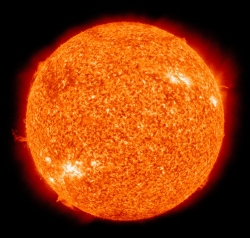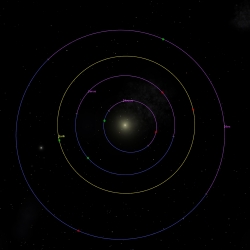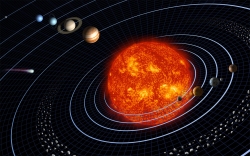For a very long time, people have looked up at the night sky. Years ago, farmers watched the moon to know when to plant their fields. Early sailors used the blinking lights in the night sky to help them find their way at sea. Today, we have calendars, clocks, and GPS. But we still look up at the night sky. We still wonder what's floating up there in space. Think of the night sky as a map of houses, towns and states. And it all starts with our sun.
Our sun is one of millions of blinking lights in the night sky. The sun gives light and heat to the planets that circle it. At its center, it burns at a blazing 27 million degrees Fahrenheit. The sun's energy is the source of most of the energy on Earth. When the light gets to us, plants soak it up to make food. Animals and people eat plants, or other living things that ate plants, to get the fuel we need to live. Our sun is a
star, which is a super hot ball of gas in space that lets out light.

Our Sun - A giant ball of hot gas.
Eight planets circle our Sun. Think of them as merry-go-round horses. They all move around the center of the ride. The sun's pull holds the planets in place, like the Earth holds your feet on the ground. Each planet moves in an oval-shaped path. And each one has its own spot, so they do not crash into each other. An
orbit is the circle or oval-shaped path the planets follow. The sun's pull holds each one in place.

Orbits - A lot of running around in circles.
Danial79 (talk)., Public domain, via Wikimedia Commons
If you look up in the night sky, you will see far more than stars. You might see a shooting star, a really small space rock, as it races towards Earth and burns up. You might see a hunk of ice blaze across the sky. There is a lot more you cannot see; like big space rocks, dust, and more. Think of each of these as a house, a school or another part of a town. They all are organized around the town's center-- the sun. When you add them together, you have a solar system. A
solar system is a star and all the planets and other smaller pieces that circle around it.

Our Solar System - Driven by the power of the sun.
But what about all the stars you see in the night sky? They are farther away than our solar system. They are not part of it. Many of those stars have planets and other things circling them, just like we circle the sun. Each star and its surrounding bodies are like their own town in space. On Earth, when you group many towns together, you get a state. The same goes for solar systems. When you group many together, you get a
galaxy, which is a very large group of stars (between one million to one trillion of them) and everything circling them. This includes planets, stars, gas, dust, and all the other stuff too.

A Galaxy - More stars than the VMAs!
The night sky is a lot like a map. Start with a star. Add houses and schools for the heavenly bodies that circle it to make a town. Now add each star's town together to get a state. By the time you are finished, you have a map called a galaxy.
References:
"Astronomy, History of." Space Sciences. Ed. John F. McCoy. 2nd ed. Detroit: Macmillan Reference USA, 2012. Science in Context. Web. 13 Nov. 2013.
"Galaxies and galaxy clusters." World of Physics. Gale, 2008. Science in Context. Web. 14 Nov. 2013.
"Orbit." The Gale Encyclopedia of Science. Ed. K. Lee Lerner and Brenda Wilmoth Lerner. 4th ed. Detroit: Gale, 2010. Science in Context. Web. 14 Nov. 2013.
"Orbits." Space Sciences. Ed. John F. McCoy. 2nd ed. Detroit: Macmillan Reference USA, 2012. Science in Context. Web. 14 Nov. 2013.
"Solar System." World of Earth Science. Ed. K. Lee Lerner and Brenda Wilmoth Lerner. Detroit: Gale, 2010. Science in Context. Web. 14 Nov. 2013.
"Star." UXL Encyclopedia of Science. U*X*L, 2007. Science in Context. Web. 13 Nov. 2013.
"Sun." World of Physics. Gale, 2001. Science in Context. Web. 14 Nov. 2013.